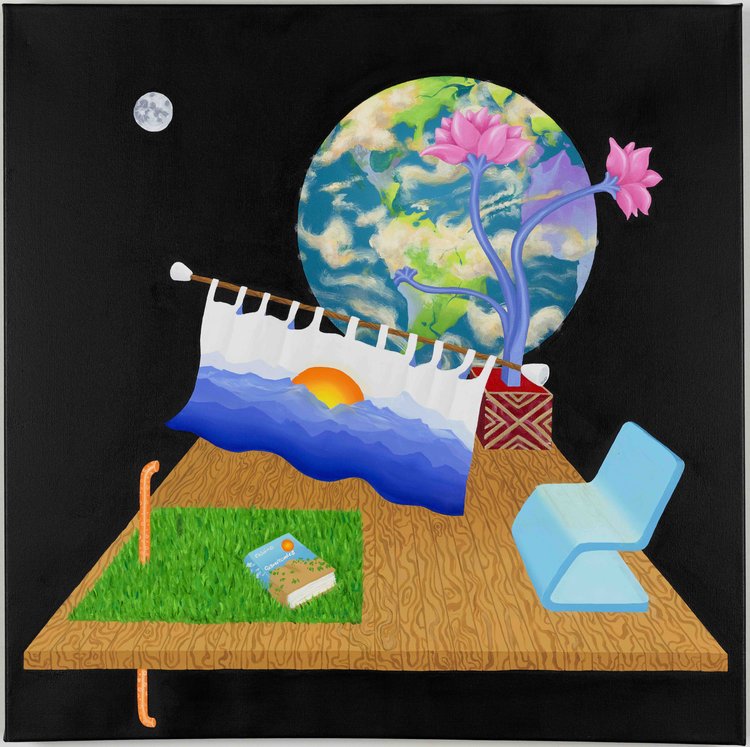Extraction
2017-2021
Agricultural Landscape
Acrylic on Canvas
36”x36”
August 15, 2021
Desert Golf
Acrylic on Canvas
24”x24”
April 30, 2020
Hutt Lagoon
Acrylic on Canvas
36”x36”
December 9, 2018
Lake Houses
Acrylic on Canvas
24”x24”
April 1, 2018
IJsselmeer
Acrylic on Canvas
36”x36”
July 4, 2019
Grande Dixence Dam
Acrylic on Canvas
36”x36”
October 28, 2018
Arctic Oil Rig
Acrylic on Canvas
24”x24”
July 7, 2018
Coal Terminal
Acrylic on Canvas
24”x24”
September 21, 2018
Potash Pond
Acrylic on Canvas
24”x24”
December 30, 2017
Extraction: in the nexus of creative desire and scientific inquiry
The paintings of Extraction were created in the intersection of landscape and abstraction. I sought the freedom of expression through automatic movements of my hands, rather than trying to exact the slice of nature’s chaos. I imagined what Georgia O’Keeffe saw in the air, a landscape that transforms into a tapestry of colors in abstraction[1]. The paintings of Extraction attempt to capture this blurring of boundaries and scales. At the same time, the paintings of Extraction are created through a negotiation of creative desire and scientific inquiry into the extractive human existence on Earth.
These paintings demonstrate how I blend and blur my identities as a scientist and an artist. I learned to accept this hybridity and found the vocabulary to utilize this condition from a story, “Questio De Centauris[2]” by Primo Levi, who was a chemist and a writer, another hybrid being. Stories can change the way we exist in the world by revealing our identities and motivating actions.[3] So, I decided to tell the stories about human relations with the natural world using my hybrid vocabulary. To tell a story effectively, the audience must not only be captivated but also feel as a participant connected to the labor that went into determining the fates told in the stories. To tell the stories about human’s extractive use of Earth’s natural resources, scientific language alone does not suffice because, as Primo Levy puts it, “official science often lacks humility.2” And stories don’t resonate in the atmosphere of intimidation. Art, on the other hand, offers a place for the audience to open their mind and imagine. This way, art can effectively deliver the stories that are often unheard.
Rachel Carson was an effective storyteller. She opened many people’s minds about our natural environment, and how all life on Earth is in continuous interactions[4]. All animals extract from Earth in one form or another, and after some time, they return what they have taken with their bodies. If the system is in some sort of dynamic equilibrium, the time lag, between one’s birth and the ultimate integration back into the Earth’s system, is dampened by the larger rhythm of life that regulates the Earth’s processes. However, humans have developed the capacity to accelerate this natural rhythm of life through extraction of resources that empowers us with technologies to control nature. Human extraction of natural resources has become systematic and expansive to feed the economic system, the social domain that coordinates the flow of production, distribution, and consumption. Humans have chosen to annuitize the natural resources with a short-term maturity reached by progressively large payouts; as a result, we began to produce more and flood the market with excess consumer goods, and people began to consume more and waste more[5]. But the Earth’s natural resources are finite, and the human economic system cannot grow infinitely. Moreover, scientific evidence indicates that human actions are responsible for the dramatic changes in Earth’s processes, and these changes will likely set off an irreversible chain reaction beyond human control.
To move toward global conservation, we need cooperation among scientists, governing bodies, and the public3. Scientific studies enable us to understand Earth’s processes and develop technologies that define human domain. Government establishes policies and programs that regulate the human system and its interaction with the environment. Public ensures that the government acts in the interest of their common goal. This common goal, whether it is to maximize the present economic growth or to develop a more sustainable future, is informed by our understanding of the world. Our understanding of the world is gained through many lenses, which include science to offer practical wisdom about the world. But without the ability to expand one’s perspective, to imagine, this understanding won’t evolve into a vision for the future.
Aesthetic experiences have a biological basis.[6] Art can literally stir one’s inner mind. I was compelled to paint the places on Earth altered by human extraction because they may stir one to broaden their perspective with an inquiry into the consequences of our choices and actions. With this broader perspective, our understanding of the world may become more comprehensive, and with a more comprehensive understanding of our place in the world, we may change the way we choose to exist on Earth. Primo Levi once said that as more people become aware that each of us is a small particle of the merit belonging to the human species, less difficult and long it will be for humanity to progress toward justice and peace. In the same lineage of logic, as more people become aware that each of us is an even smaller particle of the miracle that we call Earth, less difficult and long it will be for humanity to progress toward an inclusive and sustainable future.
Se Jong Cho
Baltimore, MD
July 10, 2021
[1] O’Keefe, Georgia. Letter to Maria Chabot, ‘In the Air’, November 1941, in Cowart, Hamilton and Greenough (eds.) 1987. P.231.
[2] Levi, Primo. Questio de Centauris. Translated, from the Italian, by Jenny McPhee.
[3] Cronon, William. A Place for Stories: Nature, history, and Narrative. The Journal of American History, 1992
[4] Carson, Rachel. Silent Spring. Boston: Houghton Mifflin, 1962
[5] Wilson, E.O., 2002. The future of life. Vintage.
[6] Chatterjee, Anjan, and Oshin Vartanian. "Neuroscience of aesthetics." Annals of the New York Academy of Sciences 1369.1 (2016): 172-194.









